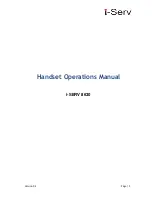
Product Description
1-9
Chapter 1 - Introduction
Loop Start CO Line Interface Board
The Loop Start CO Line Interface Board (LCOB) provides Loop Start CO Lines which support
pulse/DTMF signal. Each interface contains ring and loop current detection circuits, Analog-to-
Digital and Digital-to-Analog conversions, and pulse and ground flash signaling circuits. The
LCOB contains LEDs to indicate the in use status of each CO Line.
Three versions are available: LCOB, LCOBC, and LCOBE.
The LCOB has three RJ14 modular connectors.
The LCOBE and LCOBC have an RJ21-type male connector.
The LCOB can be equipped with a DTMF receiver unit (DTRU) to detect DTMF tones.
»
Add-on Boards: DTRU for LCOB, DTRU4 for LCOBE and LCOBC
Voice Over the Internet Protocol Card
The Voice Over the Internet Protocol (VoIP) card provides up to eight lines per card (two lines
per installed VOIP module). The VoIP card allows bi-directional voice communication to other
devices via an IP network such as an internal Local Area Network (LAN), the Internet, or a Wide
Area Network (WAN) using the Ethernet Interface. It monitors for disconnect while using
minimal bandwidth. It also provides four-digit dialing and other features.
»
Add-on Boards: VoIP modules
T1 Interface Board
The T-1 Interface Board (T1IB) provides the T-1 (1.544Mbps, 24-Voice Channel) digital interface
circuit, control circuitry, and synchronous clock control circuits. DTMF tone detection units can
be installed optionally on the T1IB. The T1IB has 8 LEDs on the front edge of the PCB which
indicates errors of T-1 line, in-use status, and synchronous clock enable status.
»
Add-on Boards: DTRU4
Primary Rate Interface Board
The Primary Rate Interface Board (PRIB) provides one Primary Rate Interface circuit. Each circuit
contains 23 bearer and one data channel (23B+D). When a PRIB card is programmed into the
system, the system interprets all B channels as trunks. Thus, one PRIB which contains 23B+D
circuits provides 23 line appearances to the system. The PRIB card uses 24 time slots when
installed.
The PRIB must usually be used in conjunction with a Channel Service Unit (CSU). Connection is
made via a DB15 from the PRIB to the CSU. When networking systems that are less than 50 feet
apart, no CSU is required.
The PRIB accepts two DTRU4 boards.
When ordering PRI lines from the telephone company, specify ESF framing and B8ZS line
coding. PRI only supports National ISDN 2 (NI-2). No other standards are supported.
»
Add-on Boards: DTRU4
Summary of Contents for STARPLUS Triad XTS
Page 1: ...STARPLUSTM Triad XTS Installation...
Page 10: ...N O T E S...
Page 20: ...1 12 Product Description Chapter 1 Introduction...
Page 22: ...N O T E S...
Page 36: ...N O T E S...
Page 42: ...3 8 KSU Installation Chapter 3 System Installation Figure 3 4 Mounting Cabinets 0 1 2 48 3...
Page 77: ...CO PBX Connections 3 43 Chapter 3 System Installation Figure 3 25 Case 2 of Clock Chain...
Page 79: ...CO PBX Connections 3 45 Chapter 3 System Installation Figure 3 27 Case 4 of Clock Chain...
Page 104: ...N O T E S...
Page 134: ...4 32 VOIP Maintenance and Troubleshooting Chapter 4 Maintenance and Troubleshooting...
Page 138: ...iv Index...
















































